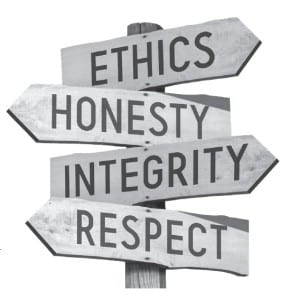People are drawn to their own values, when those values are also exhibited by businesses.
– Chuck McKay
Company Culture is Alignment of Values
It’s the shared attitudes, goals, and practices that characterize the company.
In nearly every contracting business, the owner’s values end up being those of the company.
If the owner is generous, so will be his employees.
If he treats customers honorably, so will they. If he flatters customers to their faces, but grouses about them behind their backs, he can expect the same from his employees. (Except, they’ll also be complaining about him.)
As each company grows and adds employees, they work out the actual rules of survival at the company where they work. They observe the clues and act according to the rules they’ve observed.
Did Jamie get hired because her references all praised her work ethic? Noted.
Was Roy promoted because he spent a lot of time socializing with the company owner? So it seems.
Did Liz get sent home because her skirt was too short? Yeah. She did.
Over time these rules become the actual corporate culture.
Take a Step Back and Observe
Do you recognize your company’s culture? Can you describe it?
Did you plan your culture? Do you like it? Love it? Hate it?
Do you enjoy coming to work?
Bryan Scudamore (800-Got-Junk) discovered that he didn’t like working at his own company.
“When I thought about why work had stopped being fun, I realized it was pretty simple. I didn’t like being around the people I’d hired, and at that point, they weren’t keen on me either. The environment had turned toxic, and the team didn’t believe in my vision or fit the culture I was trying to create.
The day I decided to fire all eleven employees was one of the scariest days of my life. It meant acknowledging that I’d failed as a leader, which I said when I let them all go. It also meant I’d be running the business solo for a few months while I rebuilt. But I knew at that moment that having the right people on board was more important than literally anything else. Since then, culture fit has been a non-negotiable part of our hiring strategy.”
Bryan knew exactly what he wanted his company to be: a reflection of his personal values. He wanted every employee to make the decision Bryan would have made if he had been present in every interaction with a customer.
Imagine being Bryan. In order to reach his goal, he was getting rid of EVERYONE. Not only going alone into a new direction, but also very aware that he’d just eliminated the employees who generated his revenue.
But he recognized reorganizing the company around his beliefs was critical to future success.
How Do Most Company Cultures Evolve?
 Many contractors start out freelancing. Operating their one-truck business out of their garage. Perhaps the spouse answers the phone and keeps the books.
Many contractors start out freelancing. Operating their one-truck business out of their garage. Perhaps the spouse answers the phone and keeps the books.
If business is good, they may hire a second technician. And a third. Then maybe a full-time office person who answers phones, schedules technicians, and sends out invoices. The owner hires each of these additional people because someone with at least minimal technical skills, acceptable people skills, and a willingness to work for the compensation offered is needed.
Very little thought is ever given at this stage to “what do I want my company culture to reflect?”
And now, here we are years later, realizing that culture has pretty much evolved without conscious direction to fit the day-to-day needs of a growing company.
Let’s go back to before business. To the formation of our values. To childhood.
Everyone Has Heroes
From the time we are very young we become aware of larger-than-life idols. They may be war heroes, or celebrities, sports figures, our parents, teachers, or scout leaders. We are drawn to our heroes’ bravery, or compassion, or fairness, or friendliness, or discipline. Our emulation of those values shape our personalities and our behaviors.
Ultimately they shape our business values.
Let’s say Bill, Bob, and Barry each started their own contracting business the same year. Will the average customer be able to tell which is which?
Bill is gregarious. The coffee pot is always on. He’s delighted when you drop by. He appreciates hearing about your eldest’s graduation.
Bob is less demonstrative. He plans each day. There’s little small talk or lighthearted banter in his shop. If you have business to conduct, he prefers that you make an appointment so that he can prepare for the meeting.
Barry spends a lot of time out in the community while his technicians do the work. He’s at every fundraiser. Every local service club meeting. Every high school sporting event. He’s quick to pledge his company’s help for any community service project.
All three contractors use the same scheduling software. Their tools and test equipment are nearly identical. The water heaters or air conditioners or roofing tiles or carpet padding they install are interchangeable.
But they are quite different at the point of customer contact. Because Bill, Bob, and Barry are different people, each has built a company that delivers his values to the marketplace, and determines how his staff treats customers.
It only makes sense that some prospective customers will choose one of these firms over the others, and all competitors. A significant number will say, “Hey, these people value the same things I do.” And when they make that association, they identify Bill’s, or Bob’s, or Barry’s company as their “tribe.”
Membership in the tribe is the one thing competitors can’t copy. We’ve systematized this difference as the Leveraged PersonalityTM Marketing System.
We believe the best way to share our values is through “We believe” statements. Why you need them, and how to use them, follow in Part 8 of this series.
__________
The content for this series of posts was taken from Chuck McKay’s The Personality Prescription for Contractors, available on Amazon.
Links to previous posts in this series:
Introduction
Part 3 – You’re Choosing Cheap Ones
Part 4 – Other Homeowners’ Motivations
- How Many Pancake Restaurants? - October 7, 2024
- Bringing Newcomers into the Labor Pool - January 4, 2023
- Hire Veterans Reentering the Local Job Market - December 28, 2022

